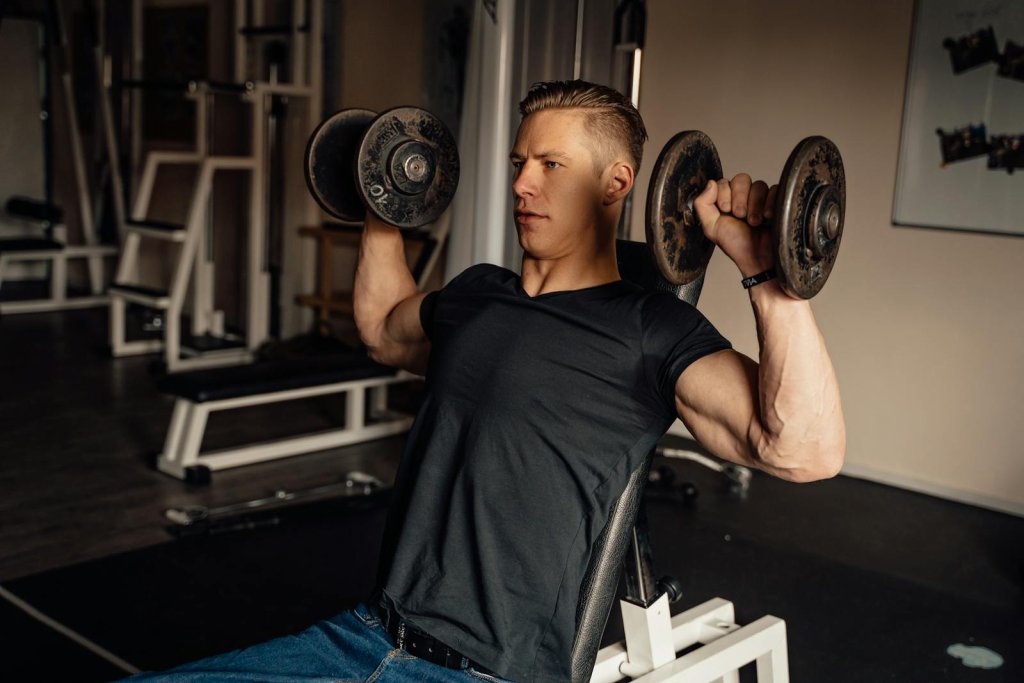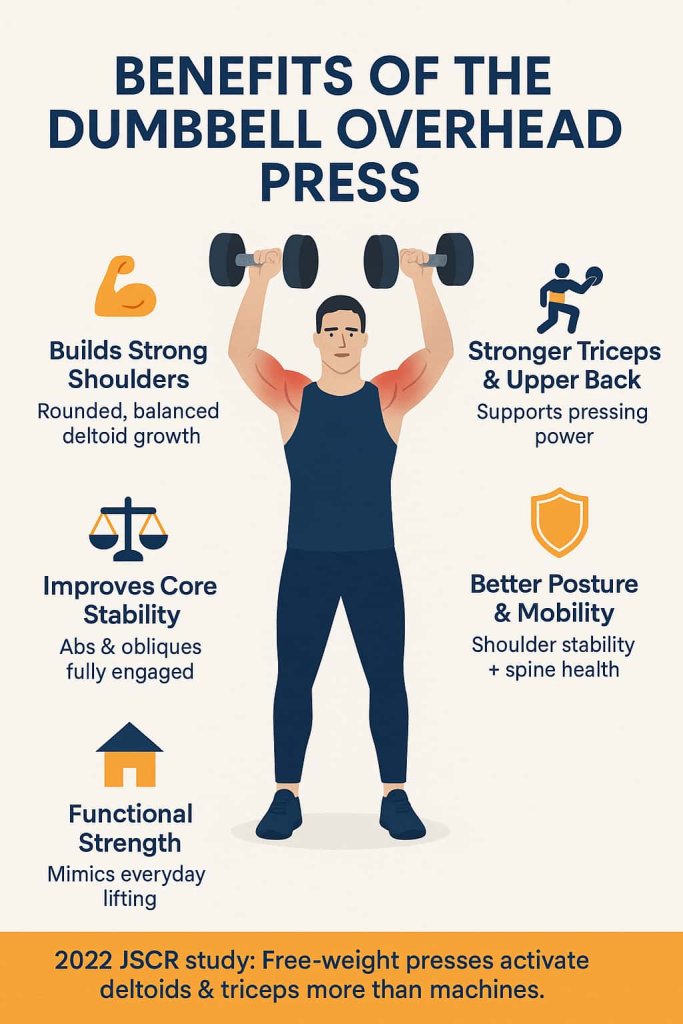The dumbbell overhead press is one of the best exercises for building strong, defined shoulders while also improving stability and posture. Unlike machines, dumbbells force each side of your body to work independently, creating balanced muscle growth and engaging your core.

Understanding proper form and avoiding common mistakes is crucial because poor execution can strain your shoulders and lower back. In this guide, you’ll learn the key benefits, step-by-step form, mistakes to avoid, and variations that make the dumbbell overhead press safe and effective.
Benefits of the Dumbbell Overhead Press
The dumbbell overhead press is more than just a shoulder builder—it’s a compound movement with full-body benefits.

1. Builds Strong, Defined Shoulders
- Primarily targets the deltoids (front and side heads).
- Stimulates muscle hypertrophy for rounded, balanced shoulders.
- Helps improve aesthetics and pressing strength.
2. Strengthens Triceps & Upper Back
- Works triceps brachii, upper traps, and serratus anterior.
- Supports pressing strength in other lifts (bench press, push press).
3. Improves Core Stability
- Standing version forces you to brace abs, obliques, and lower back.
- Enhances balance and reduces injury risk in daily activities.
4. Enhances Posture & Mobility
- Strengthens muscles that stabilize the shoulder girdle and thoracic spine.
- Helps counteract forward slouching from desk work.
5. Functional & Everyday Strength
- Mimics real-life overhead movements (lifting groceries, placing objects on shelves).
- Transfers strength to sports and daily life.
👉 A 2022 study in the Journal of Strength & Conditioning Research compared barbell and machine overhead presses and found that free-weight presses produced greater activation in stabilizing muscles such as the deltoids and triceps compared to machine variations (Coratella et al., 2022).
How to Do the Dumbbell Overhead Press (Step-by-Step)
Setup
- Sit on a bench with back support (or stand with feet shoulder-width apart).
- Hold a dumbbell in each hand at shoulder height, palms facing forward or neutral.
- Brace your core, keep chest lifted, and engage glutes for stability.
Execution
- Inhale, then press the dumbbells upward in a smooth, controlled motion.
- As the dumbbells pass your head, slightly tuck chin or tilt head back for clearance.
- Fully extend arms overhead without locking out your elbows rigidly.
- Slowly lower dumbbells back to shoulder height, maintaining control.
Pro Tip: Keep wrists neutral (in line with forearms), not bent backward.
Common Mistakes to Avoid
Even experienced lifters make errors that reduce effectiveness and increase injury risk.
- Excessive Lower-Back Arching
- Over-arching stresses the lumbar spine.
- Fix: Squeeze glutes, brace abs, and use a lighter weight.
- Elbows Flaring Out
- Creates poor leverage and shoulder strain.
- Fix: Keep elbows slightly in front of shoulders, not out at 90°.
- Pressing Too Far Forward
- Dumbbells drifting forward pull stress onto shoulders.
- Fix: Move dumbbells straight upward in line with your ears.
- Shrugging Shoulders Up
- Over-activates traps, reduces deltoid focus.
- Fix: Keep shoulders down and away from ears.
- Using Momentum or “Cheating”
- Leaning back or bouncing removes tension from target muscles.
- Fix: Perform slow, controlled reps.
- Poor Wrist Position
- Bent wrists cause discomfort and instability.
- Fix: Maintain neutral wrist alignment.
Variations of the Dumbbell Overhead Press
The dumbbell overhead press is a staple for building shoulder strength, but small adjustments in grip, stance, or position can completely change the way it targets your muscles. Below are the most effective variations explained in detail.
1. Seated Dumbbell Overhead Press
How to do it:
- Sit on a sturdy bench with back support.
- Hold dumbbells at shoulder height, palms facing forward.
- Press overhead until arms are straight, then return under control.
Benefits:
- Isolates shoulders by removing lower-body assistance.
- Puts less strain on the spine compared to standing.
- Ideal for beginners or anyone with back stability issues.
Trainer Tip:
- Keep feet flat on the floor and avoid bouncing the weights off your shoulders.
- Great for hypertrophy (muscle growth) since it allows you to focus purely on the deltoids.
2. Neutral Grip (Hammer Grip) Dumbbell Press
How to do it:
- Hold dumbbells at shoulder height with palms facing each other (neutral grip).
- Press straight overhead, maintaining the same grip throughout.
Benefits:
- Puts shoulders in a safer, joint-friendly position.
- Engages anterior delts and triceps with less external rotation stress.
- Excellent choice for lifters with shoulder discomfort during traditional presses.
Trainer Tip:
- Use controlled movements—avoid letting elbows flare too wide.
- Works well in higher rep ranges for joint health and endurance.
3. Arnold Press
How to do it:
- Sit or stand with dumbbells in front of your shoulders, palms facing you.
- As you press overhead, rotate your palms outward until facing forward at the top.
- Reverse the motion slowly on the way down.
Benefits:
- Trains all three heads of the deltoid (front, side, and rear).
- Increases shoulder mobility and range of motion.
- Adds variety and hypertrophy stimulus compared to standard presses.
Trainer Tip:
- Use lighter weights at first—rotation increases difficulty and demands more control.
- Keep the motion smooth to protect your shoulders from strain.
Safety Tips Before You Start
- Warm up shoulders with light band pull-aparts or arm circles.
- Choose a weight that allows 8–12 controlled reps without form breakdown.
- Progress gradually; avoid ego lifting.
- If you have shoulder or back injuries, consult a trainer or physical therapist.
FAQs About Dumbbell Overhead Press
1. Is the dumbbell overhead press better than the barbell version?
Yes, for most people. Dumbbells allow a more natural range of motion and reduce shoulder stress, though barbells allow heavier loads.
2. Should I do it standing or seated?
Standing engages more core muscles, while seated isolates shoulders better. Beginners may prefer seated.
3. How heavy should I go?
Choose a weight that challenges you but still allows proper form for 8–12 reps.
4. Can beginners do the overhead press?
Yes, start light and focus on form. Dumbbells are safer for beginners than barbells.
5. How often should I train it?
2–3 times per week is effective, usually within an upper-body or push workout.
6. What if I feel shoulder pain?
Stop immediately. Switch to neutral grip presses or consult a physiotherapist.
Conclusion
The dumbbell overhead press is a powerhouse exercise for building strong shoulders, triceps, and core stability. When performed with proper form, it improves posture, strength, and functional movement. Avoid common mistakes like arching your back or flaring elbows, and you’ll get maximum benefit while staying safe.
👉 Start with light dumbbells, focus on technique, and gradually build strength. Your shoulders will thank you.
